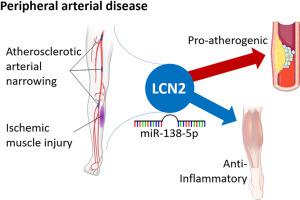Atherosclerosis ( IF 4.9 ) Pub Date : 2023-10-11 , DOI: 10.1016/j.atherosclerosis.2023.117343
Goren Saenz-Pipaon 1 , Eva Jover 2 , M Leontien van der Bent 3 , Josune Orbe 4 , Jose A Rodriguez 5 , Amaya Fernández-Celis 2 , Paul H A Quax 3 , Jose A Paramo 6 , Natalia López-Andrés 2 , Jose Luis Martín-Ventura 7 , Anne Yaël Nossent 3 , Carmen Roncal 5

|
Background and aims
Peripheral arterial disease (PAD) is a leading cause of morbimortality worldwide. Lipocalin-2 (LCN2) has been associated with higher risk of amputation or mortality in PAD and might be involved in muscle regeneration. Our aim is to unravel the role of LCN2 in skeletal muscle repair and PAD.
Methods and results
WT and Lcn2−/− mice underwent hindlimb ischemia. Blood and crural muscles were analyzed at the inflammatory and regenerative phases. At day 2, Lcn2−/− male mice, but not females, showed increased blood and soleus muscle neutrophils, and elevated circulating pro-inflammatory monocytes (p < 0.05), while locally, total infiltrating macrophages were reduced (p < 0.05). Moreover, Lcn2−/− soleus displayed an elevation of Cxcl1 (p < 0.001), and Cxcr2 (p < 0.01 in males), and a decrease in Ccl5 (p < 0.05). At day 15, Lcn2 deficiency delayed muscle recovery, with higher density of regenerating myocytes (p < 0.04) and arterioles (αSMA+, p < 0.025). Reverse target prediction analysis identified miR-138-5p as a potential regulator of LCN2, showing an inverse correlation with Lcn2 mRNA in skeletal muscles (rho = -0.58, p < 0.01). In vitro, miR-138-5p mimic reduced Lcn2 expression and luciferase activity in murine macrophages (p < 0.05). Finally, in human serum miR-138-5p was inversely correlated with LCN2 (p ≤ 0.001 adjusted, n = 318), and associated with PAD (Odds ratio 0.634, p = 0.02, adjusted, PAD n = 264, control n = 54).
Conclusions
This study suggests a possible dual role of LCN2 in acute and chronic conditions, with a probable role in restraining inflammation early after skeletal muscle ischemia, while being associated with vascular damage in PAD, and identifies miR-138-5p as one potential post-transcriptional regulator of LCN2.
中文翻译:

LCN2 在小鼠后肢缺血模型和外周动脉疾病患者中的作用及其受 miR-138-5P 的潜在调节
背景和目标
外周动脉疾病(PAD)是全球死亡率的主要原因。Lipocalin-2 (LCN2) 与 PAD 截肢或死亡的较高风险相关,并且可能参与肌肉再生。我们的目标是揭示 LCN2 在骨骼肌修复和 PAD 中的作用。
方法和结果
WT 和Lcn2 −/−小鼠发生后肢缺血。在炎症和再生阶段分析血液和小腿肌肉。第 2 天,Lcn2 -/−雄性小鼠(而非雌性小鼠)表现出血液和比目鱼肌中性粒细胞增加,循环促炎单核细胞升高 ( p < 0.05),而局部浸润巨噬细胞总数减少 ( p < 0.05)。此外,Lcn2 −/−比目鱼肌显示Cxcl1(p < 0.001)和Cxcr2(男性 p < 0.01)升高,而Ccl5 降低(p < 0.05)。第 15 天,Lcn2 缺陷延迟了肌肉恢复,再生肌细胞 ( p < 0.04) 和小动脉 (αSMA +,p < 0.025)密度更高 。反向目标预测分析确定 miR-138-5p 是 LCN2 的潜在调节因子,显示与骨骼肌中Lcn2 mRNA呈负相关(rho = -0.58, p < 0.01)。在体外,miR-138-5p 模拟物降低了小鼠巨噬细胞中的Lcn2表达和荧光素酶活性 ( p < 0.05)。最后,在人血清中,miR-138-5p 与 LCN2 呈负相关(p ≤ 0.001 调整后,n = 318),并与 PAD 相关(比值比 0.634,p = 0.02,调整后,PAD n = 264,对照 n = 54 )。
结论
这项研究表明 LCN2 在急性和慢性疾病中可能具有双重作用,可能在骨骼肌缺血后早期抑制炎症,同时与 PAD 中的血管损伤有关,并确定 miR-138-5p 是一种潜在的转录后因子LCN2 的调节器。

































 京公网安备 11010802027423号
京公网安备 11010802027423号